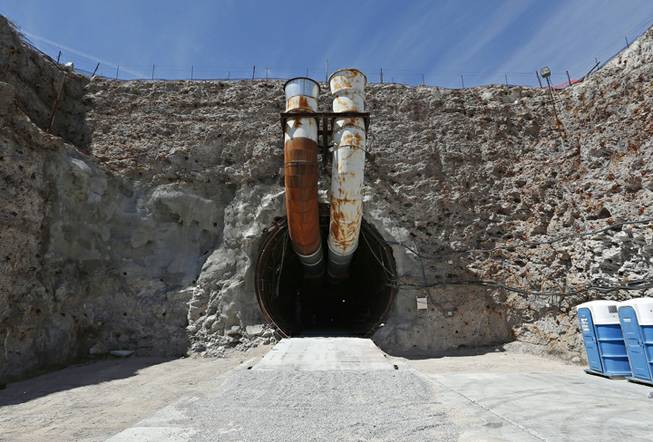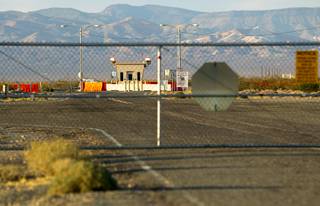
John Locher / AP
This photo shows the south portal of the proposed Yucca Mountain nuclear waste dump near Mercury.
Thursday, March 23, 2017 | 9:19 a.m.
View more of the Sun's opinion section
You’re a fear monger.
This is just a “Not in my backyard” issue.
Your arguments are emotional, not scientific.
In discussions about the Yucca Mountain nuclear waste repository, these are the three replies that opponents of the project most often hear from federal government officials and commercial nuclear industry zealots who are bent on moving forward with it.
The Nevada Nuclear Waste Task Force, now in its 30th year opposing Yucca Mountain, has produced maps that show the route waste would travel on trains to the site. It would enter Las Vegas on the Union Pacific railroad on tracks that parallel Interstate 15. The huge containers (casks) being carried on the trains would be licensed by the Nuclear Regulatory Commission. The loads are allowed to emit radiation measurable a half-mile along both sides of the tracks, an area known by regulators as the “region of influence.” Showing the mile-wide swath of the region of influence that includes many major hotels and government buildings is not fear mongering. It’s illustrating a fact.
An interesting aspect of the “not in my backyard” argument is that if a national repository were to be built in Nevada, the waste from the commercial nuclear power plants in the U.S. would go through the backyards and front yards of many millions of people in 35 states to get here. The choice of Yucca Mountain, in the Intermountain West, creates the need for waste to travel thousands of miles from where most of it originated, and still is produced, east of the Mississippi River. Like Nevadans, people in those communities would be exposed to threats they never before had to contemplate.
We are told that emotional arguments have no place in a discussion of a scientific project. I don’t think objections to contamination of the aquifer under Yucca Mountain that provides the water needed at the nearby farms and the people who live there is emotional. Hydrologists agree that eventually that pristine aquifer will be polluted with radiation — the disagreement is about how soon it will happen. Longtime Nevadans know the experience of being told that “there is no danger” when bombs were being exploded next door to Yucca Mountain at the Nevada Test Site (now the National Nuclear Security Site). People in rural areas downwind of the site were told that sacrifices were necessary for national security. These sacrifices included family member’s lives. Yucca Mountain simply means sacrifice for the failing health of the commercial nuclear power industry — more on this later.
When the Trump administration budget outline came out recently, it included $120 million to restart Yucca Mountain and a stopgap nuclear waste storage facility somewhere else.
That sounds like a lot of money, but in the nuclear waste/Yucca Mountain world it is too small to do very much. People who believe that restarting the licensing process is like flipping an “on” switch are wrong. The division within the Department of Energy responsible for Yucca Mountain involved thousands of people and a large infrastructure. When the project was halted in 2010, huge contracts were canceled and many people were laid off or reassigned, while others retired and some died. Leases on the buildings were canceled and the government building, specially outfitted for the licensing proceeding, was repurposed. Yucca Mountain is returning to nature, including becoming home to animals that enjoy shade.
To restart the project, new space can be rented and new equipment bought but the big task would be to find people with the experience, expertise and ability to get things moving. Once hired, those people would need to come up to speed on more than 20 years of work that had been performed at the site and also be able to update the obsolete license application, reflecting all previous work as well as critical new information.
Right now, Yucca Mountain is a long ridge with a large U-shaped tunnel in it that provides access. To become a repository, more than 40 miles of tunnels would have to be drilled for waste emplacement and new design work done in an attempt to overcome the natural flaws in the site. Yucca Mountain should have been disqualified in 1999 when two previous Nevada governors co-wrote a letter to the DOE pointing out the dangerous pathways for water within the geology that would lead to releases of radiation.
The world has never built a successful deep geologic repository. Until 2014, the DOE touted the success of its Waste Isolation Pilot Project in New Mexico where waste less radioactive than that planned for Yucca Mountain is disposed. It is waste from weapons production facilities, in containers that can mostly be handled by workers with minimal protection. Some requires remote handling, but is nowhere near as deadly as the waste from commercial nuclear power plants.
In 2014, due to human error and a lapse in quality assurance oversight, the wrong absorptive material was placed into a number of containers at a weapons lab that were shipped to WIPP and placed underground in a disposal room. Two of the containers blew their lids off and leaked radiation into the interior of the facility and out the vents. WIPP was shut down for three years and required $2 billion in remediation. Part of WIPP is no longer usable, and for the near future conditions underground require workers to be outfitted with full protective gear.
Going back to the 1980s, the commercial nuclear industry claimed that if the country did not provide it with a waste repository for irradiated fuel, nuclear power would die. Thirty years later we do not have a repository and almost no waste has left the plants where it was generated. We now have licensed dry casks capable of keeping the irradiated fuel safely contained at the reactor sites. The lack of a repository is not killing the industry — rather, cheaper and better ways of making electricity are making nuclear power less and less viable. Renewable energy sources like those rapidly increasing in Nevada are cleaner, cheaper, require less water, have no waste product and cannot result in the dangerous accidents associated with radiation.
Since the Yucca Mountain project started in the mid-1980s, and especially at times when problems were discovered, many people — scientists and others — began to discuss whether deep geologic disposal was really the right answer. When seeking sites for disposal, geology that has been undisturbed for millions of years and that does not have useable water running through it, are considered the best. Yucca Mountain does not meet either of those criteria.
We propose that the $120 million in the budget for Yucca Mountain be used to make sure storage at reactor sites is as safe as possible and that perhaps there are better permanent disposal ideas than shipping all of the waste with trains, trucks and barges thousands of miles through communities with millions of people. The so-called Yucca Mountain “solution” will not protect current and future generations.
Nevada is the Battle Born state and after 30 years we still say “No.”
Judy Treichel is the executive director of the Nevada Nuclear Waste Task Force.



Join the Discussion:
Check this out for a full explanation of our conversion to the LiveFyre commenting system and instructions on how to sign up for an account.
Full comments policy